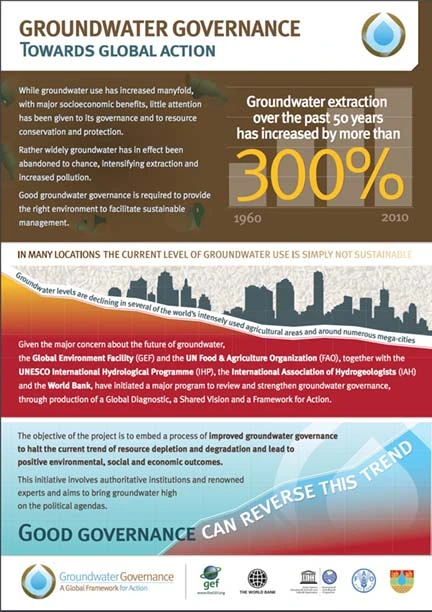Public Policy Review

I have been traveling internationally much of the time since my sabbatical started at the end of February. I spent just over one month in Israel as a Lady Davis Visiting Professor at The Hebrew University of Jerusalem, during which time I traveled to Marseille, France for the World Water Forum. In April, I spent some time in Montevideo, Uruguay attending the first regional consultation of the global Groundwater Governance Project (see groundwatergovernance.org and the Guest View in the Winter 2012 issue of this newsletter). The Project is designed to bring attention to the importance of groundwater for many regions of the world and to identify best practices or frameworks for good groundwater governance. Most recently I visited Australia, home to the famous Murray-Darling Basin and the object of much interest by water professionals. While I learned a lot during all of these trips, what these experiences have driven home is that, although we have a lot of opportunity to improve groundwater management in Arizona, we have accomplished a lot, and some aspects of our framework can be a model for other groundwater-dependent regions.
Why do I say this? Because I learned that Australians are very interested in our approach to banking Colorado River water and aquifer recharge. I spoke to this topic when addressing researchers at CSIRO, Australia’s national science research organization, and staff members at the Murray-Darling Basin Authority. While in Adelaide, I met CSIRO aquifer recharge expert Peter Dillon, who is responsible for writing the thematic paper on aquifer recharge for the Groundwater Governance project. After some one-on-one discussions and review of documents, he is featuring Arizona’s approach to managing groundwater storage in his paper.
While at the World Water Forum, I spoke about water banking as a means of connecting surface water and groundwater use, even though Arizona’s law considers them separately. Listening to others speak about how, in the context of large basins dominated by river systems, groundwater use and aquifer health are often-times overlooked, I sat there thinking, “that’s not the case in Arizona!” We have given much attention to groundwater use, particularly in the Active Management Areas, and careful consideration of both the strengths and the weaknesses of our management approach can inform other efforts, such as the Groundwater Governance Project.
Along with UA colleagues Bob Varady, Andrea Gerlak and others, I have had the pleasure of working with the policy team for the Groundwater Governance Project. One important and challenging task for the project was to offer a working definition of groundwater governance. We have built off of some existing definitions to define groundwater governance as “the process by which groundwater resources are managed through the application of responsibility, participation, information availability, transparency, custom, and rule of law. It is the art of coordinating administrative actions and decision making between and among different jurisdictional levels – one of which may be global.” Here in the United States our decentralized approach to water management requires coordination of activities among different jurisdictions. We also have regulations that require government to conduct its business in an open, transparent way. In Arizona, our framework often establishes general rules but then allows individual water users and providers to determine how to meet the regulations. We do see that information is necessary for good decision making, even though obtaining information on groundwater and aquifers can be costly and time consuming.
I do not wish to suggest that others adopt our framework without careful consideration, as we have numerous outstanding issues to address. In Arizona, we do little management of groundwater unless an area has been designated an Active Management Area. While 80 percent or more of the state’s population lives in an AMA, large areas of the state, including regions wholly dependent on groundwater, are not in an AMA. Knowing the rate at which groundwater is being depleted is important, as is knowing how much water is in storage. Additional conservation efforts and well spacing rules could benefit non-AMA regions. Requiring proof of adequate water supplies prior to subdivision development is also a regulatory issue receiving much attention. Within AMAs, where 100 years of assured water for new municipal development must be demonstrated, exempt wells, securing the water supplies for the Central Arizona Groundwater Replenishment District, and addressing areas with localized draw-down are just some of the issues water managers face. Planning for the recovery of the millions of acre feet of water stored is still ongoing, though the possibility of an official declaration of shortage on the Colorado River appears more likely than it seemed just one year ago. The list of outstanding issues is long.
In my presentations I often show a glass that is either halffull, or half–empty, depending on how optimistic or pessimistic I feel. I started this column focusing on the half-full part. Arizona’s groundwater management framework can serve as a model for others; there are many things we are doing well. But the framework is not without problems. It’s the half-empty part that we need to keep sight of because (1) we need to continue to manage water resources well on behalf of residents of Arizona, and (2) when we share our expertise, we help others and we can learn how to improve upon what we do and devise an even better system

